Cultural Treasures
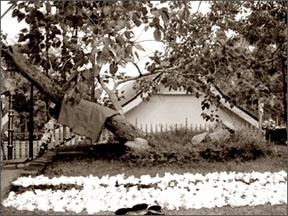
Jaya Sri Maha Bodhiya |
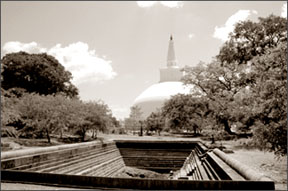
The Ruwanveliseya |
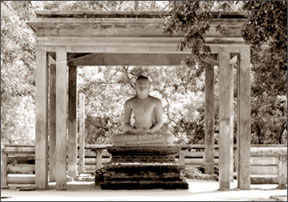
The Samadhi Statute |
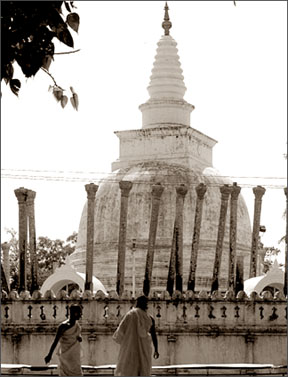
Thuparama |
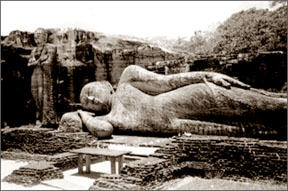
Polonnaruwa Rock Temple |
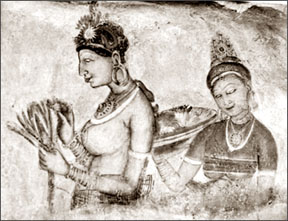
Sigiriya Frescoes |
The Cultural Triangle has been identified by UNESCO in keeping with
its mission of preserving the 'World Heritage Sites'. The sites that
come under the Cultural Triangle are Anuradhapura, Polonnaruwa, Sigiriya,
Dambulla and Kandy.
Located geographically in such a manner that when joined by three
straight lines, the area forms into a triangle and that's how it came to
be recognised. The projects initiated have a multi dimensional impact on
our country.
Basically it helps to conduct archaeological excavations, which is
still on, to further uncover hidden cultural treasures which throws
light on our links with ancient civilisation. The Cultural Triangle
provides information to interested parties to engage in historical
explorations and offers facilities to conduct experiments, to determine
the scientific nature of the archaeological findings.
Also provided are work study programmes on various aspects of
archaeology. Above all the Cultural Triangle works on the project of
finding ongoing museum facilities to exhibit the findings and to
preserve it for the future.
Anuradhapura was the citadel of Buddhist Civilisation. This kingdom
was ruled by 109 kings beginning from King Devanampiyatissa upto the
reign of King Mahinda, the 5th for a period of 14 centuries. Among
number of historical sites the following takes precedence.
Srimaha Bodhiya the sacred Bo Tree held in veneration by all
Buddhists in Sri Lanka. This is a branch from the right side of the
original Bo Tree which gave sanctuary to Lord Buddha during the final
phase of his attainment. This Bo sapling was brought to Sri Lanka, in
the third century BC by Bhikkuni Sangamittha, the daughter of Emperor
Asoka of India.
The Samadhi Statue (Lord Buddha in Meditation) is acclaimed to be a
masterpiece in sculpture by international scholars.
Thuparamaya was the first Dagaba built by the first Buddhist King of
Sri Lanka, King Devanampiyatissa.
The Ruwanweliseya is supposed to be the largest Chaithya built by the
first National hero of Sri Lanka King Dutugamunu. It is believed that
the relics of Lord Buddha are enshrined in Ruwanweliseya Chaithya.
After the decline of the Anuradhapura kingdom Polonnaruwa was ruled
by 11 Kings and Queens for 200 years. The major task of the Kings was to
restore the Cultural Heritage devastated by the South Indian Kings who
invaded Sri Lanka after the fall of Anuradhapura.
Parakrama Samudhraya is a towering symbol of the prosperity of
Polonnaruwa Era. Then the Rock temple, which is carved on a large rock
168 feet long. From the foreground 15 feet are chiselled into the matrix
of the rock to accommodate the carved statues of Mahabrana and Lord
Vishnu.
The four Buddhist statues are carved on the face of the rock
depicting four postures of Lord Buddha. The largest of four sculpted
statues is seldom seen in Buddhist architecture. Lord Buddha in upright
position with arms crossed and placed on chest with open fists.
Finally the stone inscriptions where Royal edicts inscribed on them
can be seen on the foot of the ruins. The King's Palace, ponds where the
Royal household held their aquatic games can be seen among other
historical sites.
Belligerency and unorthodox beliefs drove King Kashyapa to build a
fortress on Sigiriya rock in 477AD. He built his palace in the precincts
of the fortress to make reign a secure one.
King Kashyapa's ascendancy to the throne was controversial due to his
pedigree. The entrance to the fortress is through the mouth of a lion
only the paws of the lion can be seen today. The steps leading to the
summit of the rock is carved from mass of the Sigiriya rock. Ruins of
the King's Palace can be seen extending from the north to the south of
the rock.
Sigiriya frescos are an epic art, which can be compared to Ajantha
mural paintings of India on its artistic merit. Sigiriya painting
demonstrate the calibre of artists that are existed in ancient Sri
Lanka. The colour mixing and raw materials used has given the painting a
living and a tasting image. Critics are of the opinion that Ajantha
paintings inspired our artists and these paintings belong to two periods
of history.
Dambulla holds a pre-eminent place in Buddhist art and sculpture.
There are five cave temple complexes in South Asia. There are almost
2000 square meters of rock and wall paintings in this cave temple
complex.
There are sculpted Buddha statues, statues of various Kings and
deities in all caves. This rock cave temple complex was built by King
Wattagamini Abhaya during the 3rd century BC and is more than 200 years
old. Major events in the history of Sri Lanka are painted in these
caves.
MP
|
